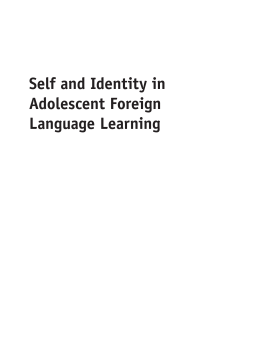
Additional Information
Book Details
Abstract
This book explores the role of identity in adolescent foreign language learning to provide evidence that an identity-focused approach can make a difference to achievement in education. It uses both in-depth exploratory interviews with language learners and a cross-sectional survey to provide a unique glimpse into the identity dynamics that learners need to manage in their interaction with contradictory relational contexts (e.g. teacher vs. classmates; parents vs. friends), and that appear to impair their perceived competence and declared achievement in language learning. Furthermore, this work presents a new model of identity which incorporates several educational psychology theories (e.g. self-discrepancy, self-presentation, impression management), developmental theories of adolescence and principles of foreign language teaching and learning. This book gives rise to potentially policy-changing insights and will be of importance to those interested in the relationship between self, identity and language teaching and learning.
Florentina Taylor delivers, for the first time, an exploration of the identity development of adolescents learning foreign languages. Her quadripolar model of identity provides creative and novel insight into how and why students actively participate in learning. If you are in any way interested in the motivational factors underlying language learning in adolescents, you owe it to yourself to read this book.
Florentina Taylor is a Lecturer in Education and MA TESOL Programme Leader at the University of York, UK. She has over 18 years' teaching experience in Higher Education, EAP and EFL and has conducted research into identity and motivation in learning and teaching English as a foreign language in Europe, as well as the perceived relevance, motivation and uptake of Modern Foreign Languages in the UK.
This is a carefully researched and well-written book that will be read with much interest and profit by those interested in the increasingly important area of identity in foreign language learning.
Readers may wonder what factors drive English language learners like the participants in the book and us; do the Romanian adolescent learners have different learning experiences from ours? In reading this book, we were not only fascinated by the findings but also felt surprised by the fact that the study had not received the attention it should have in the field of language learner motivation and identity research.
Tian Xia, East China University of Political Science and Law, China and Xuesong Gao, The University of Hong Kong, Hong Kong
Florentina Taylor's study adds a fresh and original perspective to the vibrant field of studies of the self in SLA. Reading the book will not only extend readers' understandings of adolescents' multiple relational selves and identities, but they will also gain valuable insights into a range of related psychological issues. A bold, intelligent and important contribution to this exciting field.
Table of Contents
| Section Title | Page | Action | Price |
|---|---|---|---|
| Contents | v | ||
| Tables and Figures | vii | ||
| 1 Introduction | 1 | ||
| 2 Self and Identity in Adolescence: A Relational Perspective | 9 | ||
| 3 Self and Identity in Foreign Language Learning | 26 | ||
| 4 A Quadripolar Model of Identity in Adolescent Foreign Language Learning | 41 | ||
| 5 Participants’ Self Systems in Four Relational Contexts | 62 | ||
| 6 Self Perceptions and Identity Display in Learning English as a Foreign Language | 85 | ||
| 7 Of Students and Teachers | 105 | ||
| 8 Drawing the Line: Evaluation and Implications | 121 | ||
| Appendix A: The L2 Quadripolar Identity Questionnaire | 131 | ||
| Appendix B: The L2 Quadripolar Identity Questionnaire with Item Numbers | 138 | ||
| Appendix C: Questionnaire Scales with Item Numbers | 145 | ||
| Appendix D: Interview Guide – Themes Covered, with Examples of Questions and Prompts | 147 | ||
| Appendix E: Self System Graphical Representations and Vignettes | 151 | ||
| Appendix F: Interviewee Profiles | 153 | ||
| Glossary | 170 | ||
| References | 172 | ||
| Subject Index | 191 | ||
| Author Index | 193 | ||
| Country Index | 198 |
